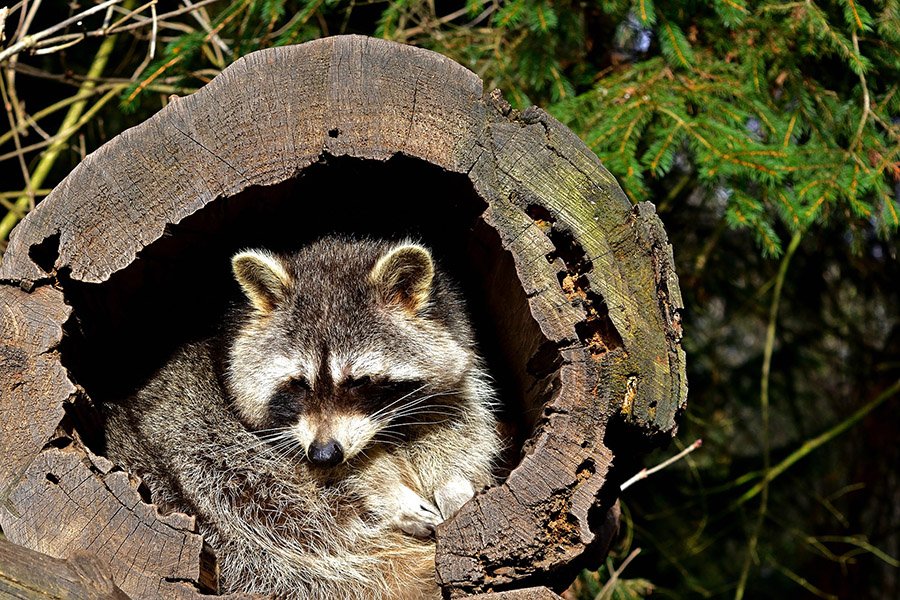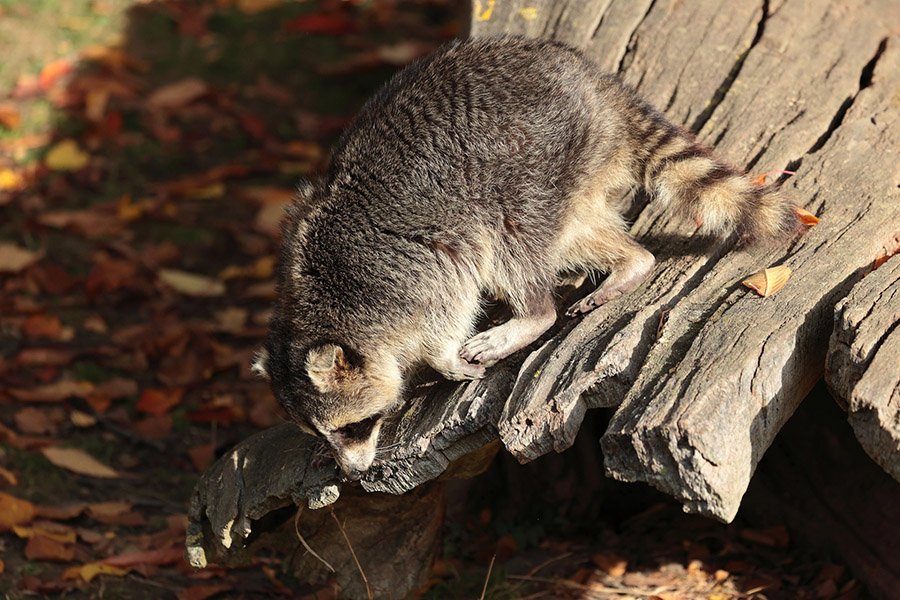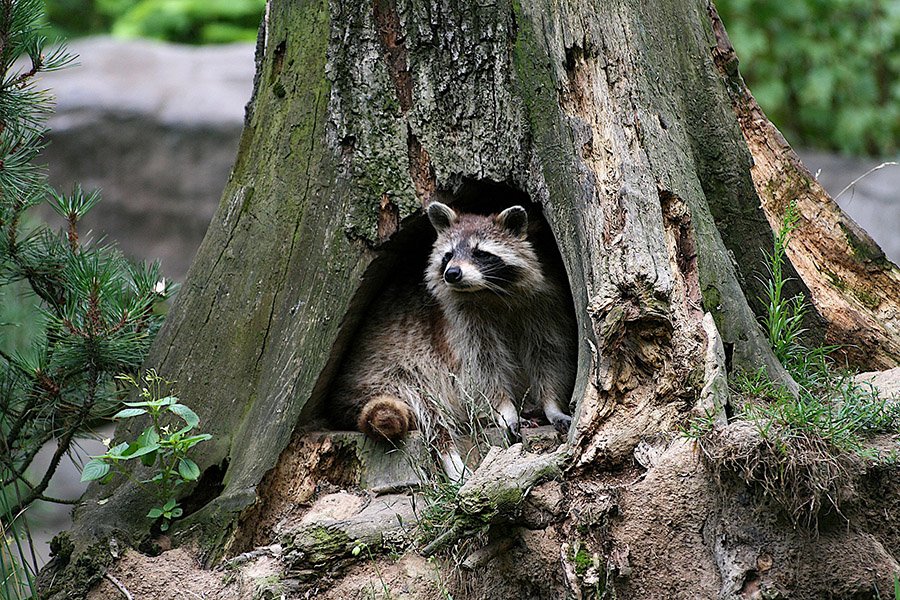Although raccoons are nocturnal animals, which means they are active during the night and sleep during the day, their sleeping habits can vary depending on various factors, such as food availability and weather conditions.
This variation often confuses people, so most wonder when and where raccoons sleep. Fortunately, this article will provide readers with comprehensive details regarding these mammals sleeping habits and address how this act enhances their survival chances in their respective habitats.
Where Do Raccoons Sleep?
Raccoons are known for being adaptable creatures that can sleep in various locations depending on their habitat and shelter availability.
Generally, raccoons prefer sleeping in tree cavities, dense vegetation, and abandoned dens or burrows. In urban areas, they sleep in attics, chimneys, or other dark and secluded places such as abandoned buildings, under decks, or roofs.
Do Raccoons Sleep in Trees?
Yes, raccoons are known to sleep in trees. In fact, sleeping in trees is a typical behavior for raccoons, as it provides them with safety from predators and other dangers on the ground.
Since these mammals can easily climb trees, using their sharp claws and strong legs, they often seek out tree cavities or hollows as a place to sleep. Additionally, mother raccoons often build a tree nest to raise their offspring.

What Does a Raccoon Den Look Like?
A raccoon den can take many forms, depending on the location and materials available. Typically, these mammals seek shelter in hollow trees, logs, rock crevices, or burrows dug by other animals.
When a raccoon creates its den, it may dig a hole in the ground or use an abandoned burrow made by another animal, such as a rabbit or groundhog. In suburban or urban areas, raccoons may settle in attics, crawl spaces, or utilize other man-made structures as den sites.
Raccoon dens are often lined with leaves, grass, and other soft materials for insulation and comfort. They may also have multiple entrances or escape routes in case of danger.
Where Do Raccoons Live During The Day?
During the day, raccoons typically rest/sleep in dens or other sheltered locations, such as hollow trees, abandoned burrows, or human home attics.
They may also seek refuge in dense vegetation or under rocks, logs, or other natural debris. In urban areas, raccoons may hide in storm drains, sewers, or other enclosed and safe structures.
When Do Raccoons Sleep?
Raccoons are primarily nocturnal animals, meaning they are most active at night and sleep during the day. They have adapted to this lifestyle and have a keen sense of sight and hearing that helps them navigate in the dark.
Do Raccoons Sleep During The Day?
Yes, raccoons sleep during the day and often seek shelter in a tree, a den, or some other safe and secluded spot to rest and conserve energy.
What Time Do Raccoons Come Out?
Typically, raccoons will come out at dusk, around sunset, and will continue to be active throughout the night until dawn.
However, raccoons are adaptable creatures and can also be seen during the day in urban or suburban areas where they have become accustomed to human activity and food sources.

How Long Do Raccoons Sleep?
On average, raccoons sleep 6-8 hours a day, usually during the daytime. However, depending on the circumstances, they may sleep for shorter or longer periods.
For example, during the winter months, when food is scarce, these mammals usually sleep for extended periods to conserve energy. Additionally, young raccoons sleep more than adults, averaging around 16 hours a day.
How Do Raccoons Sleep?
Raccoons can sleep in various positions, including curled up in a ball, stretched out flat, or even upside down with their feet resting against a tree trunk.
They often sleep by curling themselves up in a ball-like position with their head tucked under their body while using their bushy tails as insulation. They are also known to sleep with their eyes partially open, which allows them to stay alert to any potential dangers while they rest.
However, there are times when raccoons stretch out flat or assume an upside-down position when sleeping, with their feet resting against a tree trunk, especially during the winter season.
By stretching out their bodies and resting against a tree trunk, the animals can maintain a low profile/hide from their predators and conserve heat, which is essential during the colder months.
Do Raccoons Hibernate?
Raccoons do not hibernate in the traditional sense of the word. However, they undergo decreased activity and metabolism during winter, known as torpor.
During this time, raccoons will spend more time in their dens and sleep for extended periods. They may also store food to sustain them through winter when food is less abundant.
While raccoons do not fully hibernate, their torpor period can last for several weeks or even months, depending on the severity of the winter weather and food availability.

Frequently Asked Questions
Why Do Raccoons Climb Trees at Night?
There are several reasons why raccoons climb trees at night.
- One of the most common reasons is to search for food. Raccoons are opportunistic feeders who eat almost anything, including fruits, nuts, insects, small animals, and even garbage. Therefore, climbing trees allows them to access food sources that are out of reach from the ground.
- Besides food, tree tops provide raccoons with shelter and protection, allowing them to escape from predators such as dogs or coyotes.
- Finally, climbing trees is a natural behavior for raccoons. They have adapted to living in forested areas and evolved into excellent climbers. Therefore, this act allows them to move around more efficiently in their natural ecosystem.
Do Raccoons Live in Groups?
Raccoons are generally solitary animals but can live in groups depending on food availability, shelter, and mating opportunities. They are most commonly seen alone or in small family groups consisting of a female and her offspring.
Additionally, during the winter, raccoons may congregate in groups of up to 20 individuals in areas where food is abundant, such as around garbage dumps or in urban areas.
Male raccoons also form loose associations during the breeding season, competing with each other for mating opportunities with receptive females. But, these associations are typically short-lived and disband once the mating season ends.
Final Thoughts
Despite being classified as nocturnal animals, raccoons can adjust their sleeping patterns depending on their needs and environment. This flexible sleeping habit is one of Mother Nature’s most effective adaptation tactics, enabling raccoons to increase their survival chances.



